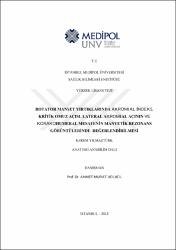| dc.contributor.advisor | Bülbül, Ahmet Murat | |
| dc.contributor.author | Yılmaztürk, Kerem | |
| dc.date.accessioned | 2021-06-29T08:32:52Z | |
| dc.date.available | 2021-06-29T08:32:52Z | |
| dc.date.issued | 2018 | en_US |
| dc.date.submitted | 2018-08-10 | |
| dc.identifier.citation | Yılmaztürk, K. (2018). Rotator manşet yırtıklarında akromıal indeks, kritik omuz açısı, lateral akromial açınının ve korakohumeral mesafenin manyetik rezonans görüntülerinde değerlendirilmesi. (Yayınlanmamış yüksek lisans tezi). İstanbul Medipol Üniversitesi Sağlık Bilimleri Enstitüsü, İstanbul. | en_US |
| dc.identifier.uri | https://hdl.handle.net/20.500.12511/7369 | |
| dc.description.abstract | Scapula'yı humerusa bağlayan m. supraspinatus, m. infraspinatus, m. teres minor ve m. subscapularis kaslarının hepsine birden omuz ekleminin "rotator manşet" kasları adı verilir. Bunlardan m. subscapularis omuz eklemini ön taraftan, m. supraspinatus üst taraftan, m. infraspinatus ve m. teres minor ise arka taraftan destekler. Böylece bu kaslar, alt taraf dışında omuz eklemini dıştan çevreleyen bir yapı oluşturur. Omuz kas aktivitesi, hareket esnasında omuz ekleminin stabilitesini korumak için sıkıştırıcı kuvvetlerle translasyonel kuvvetleri dengeler. Bu yüzden rotator manşet, art. humeri'nin statik ve dinamik stabilitesinde önemli rol oynamaktadır. Rotator manşet dejenerasyonuna neden olan etkenler ekstrinsik etkenler ve intrinsik etkenler olmak üzere ikiye ayrılır. Ekstrinsik etkenler kemiksel nedenler ve yumuşak dokulara ait nedenlerdir. İnstrinsik etkenler tendonun kendi içinde gerçekleşen olaylardır. Bu çalışmada rotator manşet yırtığına ilişkin teorilere ışık tutmak amacıyla MRG'de acromial indeks, kritik omuz açısı, lateral akromial açı ve korakohumeral mesafe değerlendirilmiştir. Retrospektif olarak yapılan bu çalışmada omuz MR'ı çekilmiş farklı yaş gruplarındaki (20-80) rotator manşet yırtığı bulunan 50 ve rotator manşet yırtığı bulunmayan 50 olmak üzere toplam 100 görüntü üzerinde ölçümler yapılmıştır. Daha önce inflamatuvar hastalığı olanlar ve travma öyküsü olanlar çalışmaya dahil edilmemiştir. Hasta grubunda akromial indeks ve korakohumeral mesafede anlamlı (p ˃ 0.05) bir fark görülmemiştir. Lateral akromial açıda ve kritik omuz açısında hasta grubunda, kontrol grubundan anlamlı (p < 0.05) olarak farklı görülmüştür. | en_US |
| dc.description.abstract | The supraspinatus, infraspinatus, teres minor and subscapularis muscles that connect the scapula to the humerus are all called "rotator cuff" muscles of the shoulder joint at once. Subscapularis supports the shoulder joint from anterior, supraspinatus from the superior, infraspinatus and teres minor from the posterior aspect. Thus, these muscles form a structure that surrounds the shoulder joint except the inferior aspect. Shoulder muscle activity balances translational forces with compressive forces to maintain the stability of the shoulder joint during movement. Therefore, the rotator cuff plays an important role in the static and dynamic stability of the shoulder joint. Factors that cause rotator cuff degeneration are divided into extrinsic factors and intrinsic factors. Extrinsic factors are the causes of bony and soft tissues. Instrinsic factors are events that occur within the tendon itself. In this study, the acromial index, critical shoulder angle, lateral acromial angle, and coracohumeral distance were evaluated in order to shed light on the theories about rotator cuff tear. In this retrospective study, measurements were made on a total of 100 images, 50 of which were rotator cuff ruptures and 50 which did not have rotator cuff ruptures in different age groups (20-80) with MR shoulders. Those with previous inflammatory disease and those with trauma traumas were not included in the study. There was no significant difference in acromial index and coracohumeral distance (p ˃ 0.05) in the patient group. Difference between the control group and patient group for lateral acromial angle and critical shoulder angle parameters were statistically significant (p < 0.05). | en_US |
| dc.language.iso | tur | en_US |
| dc.publisher | İstanbul Medipol Üniversitesi Sağlık Bilimleri Enstitüsü | en_US |
| dc.rights | info:eu-repo/semantics/openAccess | en_US |
| dc.subject | Lateral Akromial Açı | en_US |
| dc.subject | Akromial İndeks | en_US |
| dc.subject | Kritik Omuz Açısı | en_US |
| dc.subject | Korakohumeral Mesafe | en_US |
| dc.subject | Scapular Geometri | en_US |
| dc.subject | Lateral Acromial Angle | en_US |
| dc.subject | Acromial Index | en_US |
| dc.subject | Critical Shoulder Angle | en_US |
| dc.subject | Coracohumeral Distance | en_US |
| dc.subject | Scapular Geometry | en_US |
| dc.title | Rotator manşet yırtıklarında akromıal ındeks, kritik omuz açısı, lateral akromıal açınının ve korakohumeral mesafenin manyetik rezonans görüntülerinde değerlendirilmesi | en_US |
| dc.title.alternative | Evaluation of acromial index, critical shoulder angle, lateral acromial angle and coracohumeral distance in magnetic resonance images in rotator cuff tears | en_US |
| dc.type | masterThesis | en_US |
| dc.department | İstanbul Medipol Üniversitesi, Sağlık Bilimleri Enstitüsü, Anatomi Ana Bilim Dalı | en_US |
| dc.relation.publicationcategory | Tez | en_US |


















